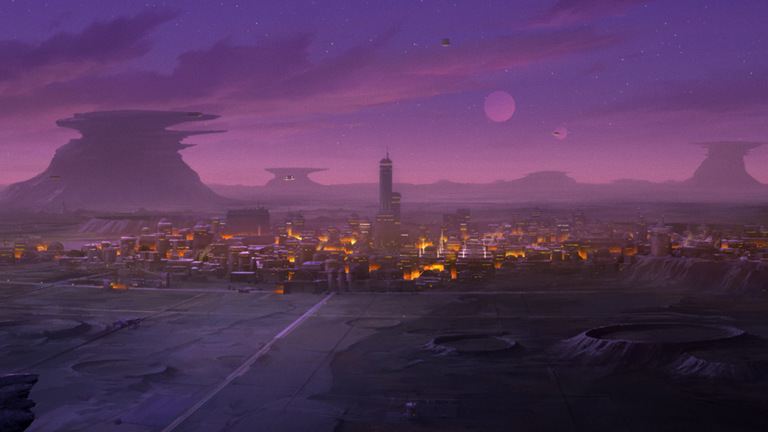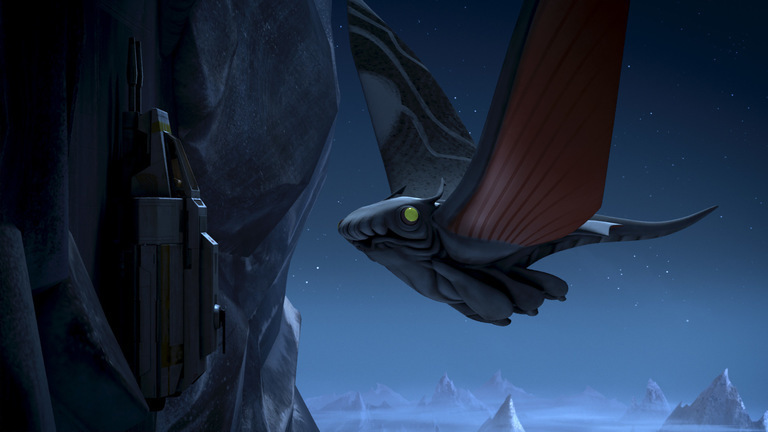My exuberant post covering the pilot movie seems a tad premature in hindsight, at least within the context of this blog and its topic. I was thrilled to see the fabled "spice mines of Kessel" in the pilot, but the new worlds that followed were decent but not particularly remarkable.
We never saw much of Garel; the Ghost crew went on a mission there to sneak a shipment of nasty weapons away from the Empire's hands, then immediately flew back to Lothal, never leaving the spaceport city. I liked the color scheme and the rock formations; it really shows the attention to detail when you consider the planet is only seen in passing for part of one episode. This makes a kind of sense; people who have to travel for their jobs don't always get to see the sights. It's why I hesitate to count states I've only made airline connections in when listing the US states I've been to.
 |
| Garel: we know nothing about it. (Image source: StarWars.com) |
 |
| Looking for lunch in all the wrong places. (Image source: StarWars.com) |
The first few episodes ended up feeling like a bait-and-switch because the rest of the season focused almost exclusively on Lothal. I knew they were planning on centering the first season on just the one planet, but I figured that would mean they would use it as a base of operations and take regular excursions elsewhere to continue their resistance ops. Instead, it became something like a running gag: need to find a Jedi outpost temple? It just happens to be on Lothal. Lando freakin' Calrissian needs to hire the Ghost? The job involves a quick rendzevous in deep space before returning to Lothal. Ezra has a Force vision of meeting Senator-in-Exile Gall Trayvis? Guess who's coming to Lothal. How many times can a crew of five people plus one droid have run-ins with the Imperial Forces and still expect to be safe plopping the ship down in some random field? Doesn't this tyrannical regime have surveillance satellites?
For the finale though, the crew does leave Lothal to mount a rescue mission to...Mustafar.
OK, I'm just going to stop you right there. It was bad enough when we saw Mustafar in The Clone Wars. We don't need all these supposedly isolated, remote Outer Rim worlds to keep showing up. It makes sense when a prominent Core World like Coruscant appears regularly, but really, in a galaxy as large as the GFFA, we don't need to keep recycling locations. If I had to give this problem a name it would be "Tatooine Syndrome." In the context of the films there are (usually) good reasons to keep coming back, but expanded universe authors only made it worse. I really hope that desert planet in the Episode VII trailer isn't Tatooine. There's got to be other desert planets in the galaxy.
In spite of this, I have to admire the writers for making a bold move and focusing on the characters, not the scenery. But it is hard to give justice to characterization when an episode is only half an hour long minus commercials. Hour-long cartoons are rare, but I think the show could use some more space to stretch. This show is very good. The only reason I'm really complaining about it is because it doesn't provide me with much to talk about in this space. And the good news is, it looks like the crew will be moving around a lot more from here on out.
Oh, I can't talk about Rebels planets without mentioning John Jackson Miller's tie-in novel: Star Wars: A New Dawn. Appropriately named, as it is the first novel in the new Disney continuity. I picked this one up eagerly because it provides an excellent view into how former Jedi apprentice Kanan Jarrus and Rebel agent Hera Syndulla first met.
 |
| I'm a fan of these more realistic versions of the cartoon characters. The previous sentence is one I've never uttered before and probably never will again. (Image source: TVTropes) |
Like the show, this book is also set on the frontier, and focus is given to two mining worlds: ugly Gorse, a tidally locked planet with burning desert on the day side, and muggy mud flats on the night side with constant threat of earthquakes; and Cynda, its moon, a shining silvery sphere interlaced with crystal formations. Turns out that these formations are also keeping it from breaking apart from tidal stresses when interacting with its sister world, and this is a plot point...
We also get a glimpse, from space, of Calcoraan, a planet in a neighboring star-system that is described as blood-red from space due to its oceans of chromyl chloride.
Bravo, Mr. Miller! I've read a lot of sci-fi novels, and Star Wars novels in particular, and one of my pet peeves is that the planets that form the settings of these stories are all too often glossed over. This is particularly to the detriment of Star Wars because it has always been a very visual series. It was the special effects that made it a worldwide phenomenon back in '77. We remember the costumes - Darth Vader's armor, Princess Leia's hair, Yoda's ears - the starships - the X-wing, TIE Fighter, Millenium Falcon - and the planets - hostile Tatooine, frozen Hoth, verdant Endor, vibrant Coruscant, poor Alderaan. But here, the author fleshes out the setting, and then weaves the details of the setting into the plot. These are mining worlds, not cushy homeworlds like we see elsewhere, so Miller has freedom to invent more bizarre worlds. I don't even care whether these worlds are plausible or not; they're unique.
Overall, Rebels is the bolt of lightning Star Wars has needed, more so than The Clone Wars. If you haven't watched it, you should. It beautifully recaptures the spirit of the original trilogy: a beleaguered band of heroes battling the Empire; space dogfights; lightsaber duels; narrow escapes into hyperspace. Rebels has it all. Kanan, Hera, Zeb, Sabine, Ezra, and Chopper prove that the continued popularity of this series isn't just nostalgia points; Star Wars is good.
 |
| I don't know what they're reacting to, but whatever it is, pretty sure it's about to be utterly demolished. (Image source: StarWars.com) |
Bring on Season 2!

